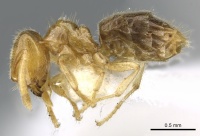Acropyga gelasis
| Acropyga gelasis | |
|---|---|

| |
| Scientific classification | |
| Kingdom: | Animalia |
| Phylum: | Arthropoda |
| Class: | Insecta |
| Order: | Hymenoptera |
| Family: | Formicidae |
| Subfamily: | Formicinae |
| Tribe: | Plagiolepidini |
| Genus: | Acropyga |
| Species group: | myops |
| Species: | A. gelasis |
| Binomial name | |
| Acropyga gelasis LaPolla, 2004 | |
This species is only known from its type locality.
Identification
LaPolla (2004) - A member of the Acropyga myops species group. A member of the Acropyga myops species group. Worker: 11 segmented antennae; head and mesosoma brownish-yellow, gaster darker; clypeus broad, with distinct beak-like tip medially; median portion of head and posterior margin with many erect hairs; appressed hairs on head sparse, none on mesosomal dorsum. Queen: unknown. Male: unknown. Compare with Acropyga hystrix.
With a unique "beak-like" medial portion of the anterior clypeal margin, A. gelasis is fairly easy to separate from other species. The structure of the anterior clypeal margin, "the beak", is similar to that of the butteli species-group, though it seems to be a result of convergence rather than indicative of a close relationship. Overall, this species, along with Acropyga hystrix, is darker (brownish-yellow) and with less pilosity than other Acropyga species.
Keys including this Species
Distribution
Latitudinal Distribution Pattern
Latitudinal Range: -1.466666667° to -1.466666667°.
| North Temperate |
North Subtropical |
Tropical | South Subtropical |
South Temperate |
- Source: AntMaps
Distribution based on Regional Taxon Lists
Indo-Australian Region: Indonesia (type locality).
Distribution based on AntMaps
Distribution based on AntWeb specimens
Check data from AntWeb
Countries Occupied
| Number of countries occupied by this species based on AntWiki Regional Taxon Lists. In general, fewer countries occupied indicates a narrower range, while more countries indicates a more widespread species. |

|
Estimated Abundance
| Relative abundance based on number of AntMaps records per species (this species within the purple bar). Fewer records (to the left) indicates a less abundant/encountered species while more records (to the right) indicates more abundant/encountered species. |

|
Biology
|
Castes
Known only from the worker caste.
Nomenclature
The following information is derived from Barry Bolton's Online Catalogue of the Ants of the World.
- gelasis. Acropyga gelasis LaPolla, 2004a: 62, fig. 26 (w.) INDONESIA (Banggai Archipelago).
Unless otherwise noted the text for the remainder of this section is reported from the publication that includes the original description.
LaPolla (2004) - The species' placement within the myops species-group is based on the fact that A. gelasis possesses widely separated torulae and mandibles that appear similar to Acropyga myops. Worker morphology suggests A. gelasis is closely related to Acropyga hystrix.
Description
Worker
(n=5): TL: 2.09-2.31; HW: 0.528-0.538; HL: 0.557-0.599; SL: 0.406-0.432; ML: 0.59-0.687; GL: 0.921-1.09; CI: 88.31-96.59; SI: 76.75-81.05.
Head: brownish-yellow, darker toward apex; head longer than broad; posterior margin concave medially; short erect hairs scattered from median portion of head and along posterior margin; 11 segmented, incrassate antennae; scape reaches to nearly reaches (approximately 1/3 length of pedicel) to posterior margin; scape with short erect hairs toward apical end; clypeus broad, convex medially; median portion of anterior clypeal margin projects forward, giving it distinct "beak-like" appearance in full frontal view; mandible with 6 teeth; 3rd tooth from apical often smaller than others; inner mandibular margin uneven. Mesosoma: brownish-yellow; in lateral view, pronotum rises steeply toward mesonotum; pronotum with short erect hairs anteriorly and longer erect hairs posteriorly; mesonotum rounded, with many short and longer erect hairs dorsally; mesonotum slightly higher than propodeum; metanotal area distinct; propodeal dorsum flat, rounding into steep declivity. Gaster: petiole thick and erect, reaching height of upper portion of propodeal spiracle; gaster dark brownish-yellow; with a layer of appressed hairs, scattered longer, erect hairs throughout.
Type Material
Holotype worker, INDONESIA: Banggai Arch., Potil Kecil, I 28'S, 123 34' E (M.J.D. Brendell) (The Natural History Museum); 14 paratype workers (BMNH) (Museum of Comparative Zoology). The holotype is labeled JSL TYPE #109.
Etymology
The specific epithet gelasis is Greek for to laugh, alluding to the odd looking medial point of the anterior clypeal margin.
References
- LaPolla, J.S. 2004a. Acropyga of the world. Contributions of the American Entomological Institute. 33(3):1-130. (page 62, fig. 26A, worker described)
References based on Global Ant Biodiversity Informatics
- LaPolla J.S. 2004. Acropyga (Hymenoptera: Formicidae) of the world. Contributions of the American Entomological Institute 33(3): 1-130.

